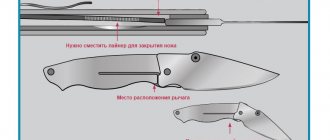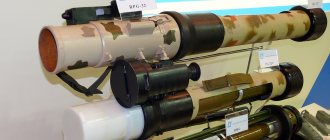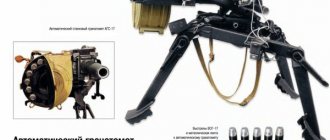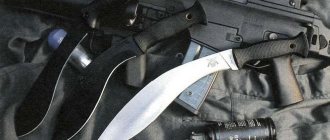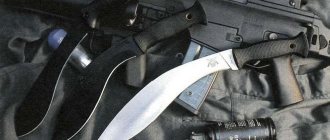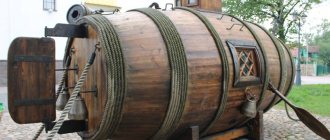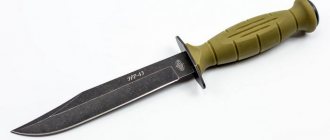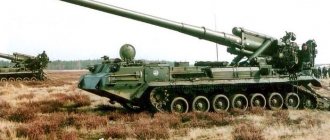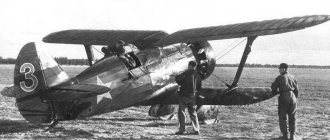combat knife is one of the first types of weapons that people began to use. A knife is one of the first weapons made by an intelligent creature, because even monkeys can use a stick and stones for self-defense. Years passed, historical eras changed, people learned to use new materials for their needs, improved methods of processing them, and after the era of stone came the age of metal. But the combat knife remained a faithful friend of a man, a hunter and a warrior.
Modern knives have changed little in appearance. Of course, today edged weapons are made from perfect materials, taking into account all ergonomic requirements, but these weapons have not undergone fundamental changes. The combat knife resembles an ocean shark - a predator that appeared on our planet millions of years ago, survived dinosaurs and mammoths, and today remains one of the deadliest creatures of the sea.
There is an opinion that the importance of edged weapons in modern warfare has decreased to almost zero. There is indeed some truth in this; the time for bayonet attacks is long gone. However, the importance of edged weapons (primarily combat knives) during special operations does not decrease.
The modern world is a world of local conflicts, hybrid wars and semi-guerrilla or guerrilla warfare, where special units come first. Soldiers of the mass armies of the Cold War also had individual edged weapons; in the Soviet army it was a bayonet-knife, but it can hardly be called the standard of a combat knife; it is usually used by military personnel to perform everyday functions.
It should be noted that a bayonet would hardly make a good combat knife. The fact is that the knife and the bayonet are too different from each other, they perform different functions. The bayonet is attached to the barrel of the weapon, the blow is applied with both hands at once, the fighter’s body weight and the weight of the weapon are involved in it. The bayonet does not need to be too sharp; it will already perform its functions. The requirements for a combat knife are completely different.
A real combat knife is a true work of weapon art. Everything is calculated in it: blade length, handle shape, sharpening and balance. A conscript soldier is unlikely to be able to use it effectively; knife fighting is a real art that takes a long time to learn. Such a weapon is perfect for special forces soldiers; it is perfect for close combat, for silently removing sentries or penetrating a guarded enemy facility.
For a long time, Europe developed firearms, improved artillery and invented machine guns. The knives seemed like outdated “medieval” weapons that belonged in museums or as part of a ceremonial uniform. The situation changed dramatically during the First World War, when it became clear that troops did not have normal bladed weapons for hand-to-hand combat in trench warfare. Soldiers of the warring sides began to make homemade blades on a massive scale or shortened bayonets that were in service.
Combat knife and its features
According to the definition, a combat knife is a type of bladed weapon designed to destroy enemy personnel. Usually it is officially adopted by the army or other law enforcement agencies.
combat knife not only has specific characteristics, but also has a special legal status that distinguishes it from household, hunting, cutting and other types of knives. The storage, use and sale of such knives is regulated by law in most countries. Such attention from the law is based on one very important circumstance: combat knives are a type of bladed weapon designed specifically for killing a person.
The designs of combat knives may be different, their appearance may differ, but in their manufacture certain principles and features are always taken into account, which allow this type of edged weapon to perform the functions assigned to it.
Masters of knife fighting say that a skilled fighter can successfully use any knife , but in order to be as effective as possible, a weapon must meet certain parameters:
- The handle of a combat knife should have an ovoid or oval cross-section, it should not be round. The reasons for this design are very simple: firstly, a handle of this shape fits more comfortably in the hand, and secondly, the fighter can feel the position of the blade at the time of its use.
- In addition, the handle of a combat knife should not slip in your hand. Today, various types of plastic are most often used for linings, which perfectly meet this requirement.
- For a combat knife, double-sided or one-and-a-half sharpening is desirable. Using a knife in combat is much more effective if the fighter can use both sides of the blade without turning it over.
- For a combat knife, the width of the blade is important; it should be at least 2.5-3 cm. In this case, the width of the blade slopes allows you to reduce the sharpening angle of the blade, which increases its cutting properties. When stabbed with such a knife, extensive wounds with profuse blood loss are left.
- The shape of the blade is very important for a combat knife. The best option is a leaf-shaped blade with differentiated sharpening. This allows you to deliver effective cutting and piercing blows. The combination of differentiated and reverse sharpening is especially effective. combat knife can also be equipped with serrated sharpening. However, the chamfer on the butt of the knife should not be confused with its sharpening.
- combat knife must have a limiter on the handle. This is necessary so that during a stabbing blow the hand does not slip onto the blade. The handle with the limiter should be comfortable for the fighter; the limiter (it is often mistakenly called a guard) should not be too large and interfere with intercepting the weapon.
- The overall length of the combat knife is no less important. As a rule, such weapons have a length of 18 to 30 cm. The size is very important; if the knife is shorter than the specified length, then in battle it will be more difficult for them to reach the enemy, whose weapon may be longer. A length of more than thirty centimeters makes the knife too heavy and uncomfortable to carry and use. In addition, a knife that is too long is difficult to quickly get out and hide securely under clothes. The specified length is quite sufficient to damage vital organs of the abdominal cavity and chest at any angle of impact. A knife that is too long is easier to knock out of your opponent's hand.
- Blade hardness. This is one of the most important characteristics of a good combat knife; it must be made of high-quality steel with a hardness of no less than 47-55 HRC. The hardness of the blade ensures good penetration, it should be able to pierce clothing and, if necessary, push apart the fibers of Kevlar body armor. However, the penetrating effect of a combat knife depends not only on the hardness of the steel from which it is made, but also on the shape of its tip. In the 90s of the last century, experiments began on creating blades from titanium and titanium alloys. These materials are stronger than steel , have less weight, and are not subject to corrosion. In addition, they have anti-magnetic properties, which is very important for divers working with underwater mines. Such materials have an unpleasant feature: sharpening very quickly loses its sharpness.
- For good penetrating ability during stabbing blows, the tip should coincide as much as possible with the axis of symmetry of the blade. That is, the tip of the knife should not be shifted to the side; when striking, maximum force should be focused on it. In hunting knives, the tip is usually shifted slightly upward, which is determined by the specifics of their use.
- The weight of a combat knife should be 200-300 grams. It is difficult to inflict a serious and deep wound with a lighter weapon, but if the knife is too heavy, this will create difficulties in its use.
- The center of gravity of a combat knife should be closer to the handle, and not to the tip of the blade, in this case it is much easier to use.
- There are also requirements for the sheath of a combat knife. They must be durable, lightweight, comfortable and firmly attached. The color of the scabbard is tactical ( black or just dark). There should be no fasteners to hold the knife in the sheath; they may prevent you from removing the weapon at the right time. The knife should be held in the sheath only by friction, and should not slip or fall out in any position of the body. The weapon should be easy to reach even with one hand without the slightest noise. The scabbard and its fastening should not interfere with the fighter’s movements and disrupt his camouflage.
Currently, personal protective equipment against various dynamic injuries is becoming increasingly popular. It is quite problematic to pierce them with a knife. Therefore, the main targets for a combat knife were not the internal organs of the enemy, but his open parts of the body (neck, face, forearms).
It must be added that combat knives knives are developed for this purpose , having a special shape, weight, size and balancing.
Types of military knives
There are several types of military knives, but the most common among them is the bayonet knife. Due to its versatility, this type of military knife has a high level of usefulness during combat missions. The bayonet was used in different ways:
- as a tip on a firearm;
- in hand-to-hand combat;
- when performing household activities.
Military knives of the bayonet type are capable of delivering a strong piercing blow, this is due to the symmetry of the blade, its double-sided or one-and-a-half-sided sharpening, as well as the special design of the handle with special attachments to the barrel of the weapon.
Another option for a military knife is the stiletto. The peculiarity of this type of knife lies in the original shape of the handle, which is made in the form of brass knuckles. Due to their maneuverability and versatility, such knives are very popular in the military industry. Such knives were introduced into use by the American army, but they quickly spread throughout the world. The fact that the knife is held very tightly in the hand gives it great efficiency, and this in turn contributes to the fact that in the process of striking, penetration occurs as much as possible.
Military knife design
Despite the fact that now more and more manufacturers of military-grade knives are trying to make more modifications and make weapons more adaptable, all knives have an identical structure. Among the standard and basic elements of any military knife are:
- blade;
- lever;
- blade;
- bevel;
- hangers;
- blade on the butt;
- crosspiece;
- thumb rest;
- shank;
- strap holes;
- pommel.
Depending on the type and purpose of a military knife, its components may change or be supplemented; for example, a bayonet knife is typically attached to a rifle. Nowadays, special military tactical knives are produced using innovative technologies. For example, the trend of combining a military knife and elements of survival knives is now considered very popular. It is this technology that is now used for the manufacture of most military knives; thanks to this production principle, it has been possible to significantly expand the capabilities of military knives.
In addition, very often the production of military knives occurs with the maximum simplification of its design. These knives look very simple, but at the same time they do not lose their functionality. This knife is made in the form of a blade, which has a solid shank that runs along the entire length of the handle. The handle of such knives has a hole for a lanyard. In order to make such a knife practical and versatile, its butt is sharpened in the shape of an ax blade, and part of the blade is made in the form of a small saw. This design of the knife allows it to be used when chopping small branches and cutting various objects, including wire. It is very important that American military knives of this type are used to neutralize explosive equipment.
Another popular type of military knives today are tanto knives. These knives are very suitable for stabbing because the tip of the blade is slightly lowered. Due to the fact that the tanto knife can have a double-sided or one-and-a-half-sided sharpening, it is very convenient for them to strike from any position and this makes them universal. In order to ensure the safety of a military man in an ambush, most often knives of this type are made in black or gray. This is due to the fact that such knives do not reflect light and do not create glare.
Since military knives are increasingly being used for various purposes, in particular for rescue operations, they must be as functional as possible. It is very important that the knife can be freely used in various conditions and used for various purposes. In addition to its direct purpose, a good military knife should allow you to perform other actions, such as:
- cutting ropes, belts, cables;
- wire cutting;
- cutting branches;
- use as a hammer or crowbar;
- the possibility of breaking locks and so on.
It is also worth noting that military knives should have a minimum weight limit, as this will make them more convenient to use. Now manufacturers of military knives are trying to make such a device as light as possible, without losing the features of the knife. Very often, to reduce the weight of a knife, a special horizontal groove is made on its blade, which runs along the entire length of the blade. Thanks to this, it is possible to reduce the cost of metal for the manufacture of the blade and, accordingly, reduce its weight. In addition to reducing weight, this technique allows you to achieve an ideal center of gravity for the knife by shifting it.
As already stated, the correct center of gravity is very important, since it determines how comfortable a military knife will be to use. That is why the horizontal groove on the blade is considered a very effective technique, which allows you to increase the effectiveness of the knife when striking.
Modern versions of military knives and legendary knives
Today, military knives are actively being produced and improved; there is a whole series of new products of this kind of knives that are produced by different manufacturers. But even innovative technologies and equipment did not allow some modern options to outstrip established military knives.
The Buck M9 MB military knife is an army bayonet-knife for combat purposes, which has a fixed blade made of stainless steel. As expected, this model of a military knife has a one-and-a-half sharpening; moreover, in order for the knife to be strong and reliable, its surface is strengthened by nitriding. There is a saw on the butt of this knife model; in addition, the knife can serve as a cutter. The handle of such a knife is made of polymer and has a removable design principle. This knife was developed back in 1973 and its direct purpose is considered to be used in conjunction with the M-16 assault rifle. Today, there are several modifications of this knife, which differ primarily in the plasma-ceramic coating on the blade. Thanks to this coating, the knife blade does not reflect glare in the sun and has excellent anti-corrosion properties.
Another representative of common military knives can be considered the Camillus SAF - this is a combat dagger that has a fixed blade. The blade is made of molybdenum-vanadium steel and also has anodic passivation. Thanks to symmetrical sharpening, the knife blade is equally sharp on both sides. As for the handle, it is made of high-quality polymer and is characterized by an overhead principle. Despite all the advantages of this knife, it does not hit the enemy much, since it is most often used for throwing.
Charlie Davis has established himself as an experienced and professional manufacturer of knives that are made from steel blanks. Separately, it is worth noting the improved version of the Anza Model F4, called Boddington. The handle of this knife is made of micarta, the tip is spear-shaped and made of thick steel. An American military knife of this brand will be useful not only when performing military tasks, but also for hunting and for other purposes. It is important to note that Boddington has a very convenient and thoughtful design; you can order an engraving on the handle of the knife, which will successfully complement the appearance of the weapon. In addition, the company has released additional accessories for this knife model, for example, a belt sheath made of genuine leather.
KA-BAR USMC knife, which belongs to the category of army infantry knives, deserves special attention This knife model is a classic version of the Bowie dagger; it has a fixed blade made of carbon steel. This knife was developed during World War II and is still considered the most famous army knife, which is actively used by the US Marine Corps. The sharpening of this knife model is one-and-a-half-sided, and the handle is comfortable and original, since it is inlaid and made of genuine leather. In addition to its functional purpose, the knife carries a memorial mission, since it was it that was recognized as a memorial symbol of the US Marine Corps.
US military knives are also intended for combat swimmers; a striking example of such a weapon can be considered the Scuba Max Titanium . The blade of this knife model has a one-and-a-half-sided sharpening and is made of titanium-beryllium alloy. There is a sling cutter on the blade of the knife, and the guard is built directly into the removable handle, which is made of polypropylene.
SOG Bowie knife is quite popular among special forces. This knife was developed during the Vietnam War and was widely used by the Navy SEALs. Despite the fact that the very first versions of this knife look very elegant and modern, now new modifications of this model are constantly being released.
Navy Seal 2000 , has more than once become the winner in military tests . In contrast to this model, the SOG Pentagon knife is considered very compact and was created specifically for hand-to-hand combat.
These are not all representatives of famous military knives, in fact there are a lot of them, but I would like to pay attention to how exactly to choose a good military knife.
What should a good military knife be like?
It is believed that the best military knife is a multifunctional knife that can be used in various conditions and be used for various purposes. Naturally, the main purpose of any military knife is to defeat the enemy, but in addition to this, it should be useful when performing tactical tasks. When choosing a military knife, it is very important to consider the type of tasks that will be used with it.
If the knife will be used to neutralize an enemy, then it is desirable that it has high cutting properties and a sharp blade. This is due to the fact that knives designed for such purposes should easily cut through clothing and ammunition.
A lot of attention needs to be paid to ensuring that the knife can be easily hidden. In order for military knives and daggers to be hidden under clothing, they must have a minimum of additional elements. This means that for concealed carry you need to choose knives without hooks, files, unusual handles, and so on. It is recommended that the blade of the knife matches the size of its handle.
" Military Knives" read 2260 times
The design of modern combat knives
knives have become increasingly popular among sellers and consumers . A large number of experts in the field of old-school edged weapons believe that this term is not very correct and should not even be used. A tactical knife is a knife that can be used not only as a combat weapon, but also to perform household or household tasks.
Today, one of the trends in the development of combat knives has been the introduction into their design of the most successful technical solutions taken from the so-called survival knives. Another trend that is clearly visible is the maximum simplification of the knife design. In addition, a modern combat knife must be adapted to various conditions of use and be versatile. That is, to perform not only combat functions, but also to be suitable for various tactical actions, without which it is difficult for a fighter to do in combat conditions.
A combat knife must be able to quickly cut a cable or wire, remove branches or other obstacles, deal with a lock, dig a shelter, or open a can of canned food. The main challenge facing designers of combat knives today is the desire to combine the functions of a weapon and a tool in a knife.
Before starting the story about the most popular Russian and foreign combat knives, a few words should be said about the design of knives and the terminology that is used to describe them. And also say a few words about the most common blade shapes and sharpenings.
If we pick up any knife , we will see that it consists of two parts: a blade (1) and a handle (2). The blade ends with a tip (3), and the handle ends with a pommel (10). At the bottom of the blade there is a blade or cutting edge (4). On the side of the blade opposite to the blade there is a butt (6). A bevel, descent or grind is a surface that tapers towards the blade blade (5). Such a surface is called a false bevel if it does not end with a blade (for example, on the butt). It is designed to lighten the blade. For the same purpose, small grooves are made on the side surfaces of the blade - valleys (7). In addition, they improve the balance of the knife by moving its center of gravity closer to the handle.
Both fullers and false bevels are not very necessary for small and medium-sized knives; often the manufacturer makes them for aesthetic reasons.
The unsharpened part of the blade, located directly next to the handle, is called the heel of the blade (8). In this part the blade resembles an ordinary metal rectangle. The main part of the handle, by which the knife , is indicated by a handle; between it and the blade there is a cross (9), it is often (and incorrectly) called a guard. Previously, the guard served not only to protect the hand in a duel, but with its help it was possible to block the enemy’s weapon. However, today, even if a knife has a guard, it is of a decorative nature.
The part of the blade inside the handle is called the tang. There are several types of attachment of the handle to the shank. The back of the handle is called the pommel or head. Sometimes a hole is made in the head and a lanyard is inserted into it.
French combat dagger
In France
The first specially made combat dagger was the M1916 or “Venger 1870” - the “avenger”, so named in memory of the defeat in the conflict with Germany in 1870.
Standard army dagger from the period of the 1st World War. France. "Le ventuger de 1870" (The Avenger 1870)
It had a metal sheath with a wire bow that allowed it to be attached to a waist belt. The French began its production on October 7, 1915.
The official description of the French combat dagger was as follows:
- a double-edged blade with a rhombic cross-section made of ultra-strong, so-called saber steel, ending with a threaded shank;
- the guard and shank nut are made of tough low-carbon steel;
- handle made of durable wood, bushing on the handle made of tough steel;
- sheath - made of bent and sealed sheet iron, the mouth of the sheath with cross-stamped ribs to hold the blade;
- The knife and sheath are marked with the supplier’s brand.
Blade shapes
Below are examples of several blade shapes of various combat and tactical knives.
Bowie shape. This is a classic form of combat knife, which was developed back in the 19th century and named after the Texan, a national hero of the United States . The blade has a tip that resembles a duck's nose. In most cases, the blade on the butt also has a sharpening; it can be straight or curved. In its penetrating action when delivering stabbing blows, the Bowie blade resembles a classic dagger, but at the same time this knife can be safely used as a tool.
Tanto form. This form of blade is of Japanese origin, and is currently extremely popular among bladed weapon lovers. The main difference between such knives is the extreme stability of the blade tip, which is significantly massive. Thanks to this, the blade can be used as a tool and pierce serious obstacles with it without the risk of breaking it. Today there are two types of sharpening for the Tanto shape: with a concave or wedge-shaped sharpening on both sides or a sharpening that resembles a chisel.
Drop point form. A teardrop-shaped blade, usually without sharpening on the spine. These knives are more like hunting knives; they were designed as a tool rather than a weapon.
Form "Dagger". The classic blade shape with a four-lane sharpening is perfect as a weapon, but such knives are not very good as tools. A symmetrical knife , sharpened on both sides, allows the fighter to perform a greater number of tactical maneuvers. It is excellent for piercing blows and has a high penetrating effect. The blade is very light, perfectly balanced.
Spear Point form. Another example of a blade shape that provides high stability to the tip. It really resembles a spear tip, although the upper cutting edge on the butt is not sharpened and is fake. The tip of the knife is almost on the midline or shifted slightly upward. This blade shape is more suitable for combat work and is not very effective as a tool.
Hawkbill form. Knives with a blade of this shape are more suitable as a tool than for combat use. The crescent shape of the blade is great for cutting cables, ropes and belts. A blade of this shape is hardly suitable for piercing blows.
A little about the history of knives
For most of human history, it was edged weapons that decided the outcome of armed conflicts. And, although the knife usually served as a secondary weapon, mention of it can be found in dozens of historical chronicles and chronicles.
Man learned to make knives back in the Stone Age, and since then this tool has been his constant and faithful companion.
The beginning of human use of metals and the development of metallurgy led to the creation of even more effective weapons, including knives. It should be noted that at the beginning of the Bronze Age, man first began to make metal tips for arrows and spears, as well as bronze knives. Things didn’t come to swords right away: they learned to make high-quality metal weapons with a long blade much later.
Technologies for smelting iron and producing high-quality steel suitable for making bladed weapons developed faster in the Middle East and India. It was there that they were the first to learn how to make damask steel and forge Damascus steel.
It should be noted that contrary to the prevailing stereotype (mainly thanks to cinema), in Antiquity and the Middle Ages most of the troops were armed with spears, bows, axes and throwing weapons. High-quality edged weapons with a long blade were not easy to make and were very expensive. In addition, working with a sword required great skill, which took years to acquire.
It must be said that during a clash using dense combat formations, the spear and javelin were much more effective than chopping weapons (sword, axe). Even the famous short Roman sword (gladius) was used quite rarely. And combat knives were very rarely used in such battles.
Combat knives were generally rarely considered as weapons of professionals. Much more often they were armed with peasant (or other) militia, along with other types of agricultural tools. In addition, the use of massive armor made the use of combat knives not very effective.
The world of ancient and medieval edged weapons is amazingly rich and interesting. In addition to the more or less familiar European weapons, there are also the Middle East, India, China and Japan, which have rich traditions in this area. But the purpose of our article does not include a detailed study of this issue; to do this, you need to write more than a dozen books. However, several important historical points that seriously influenced the further development of combat knives need to be highlighted.
Most important was the advent of firearms, which made solid armor ineffective. This led to the rapid development of edged weapons, including various types of combat knives. In addition, it was during this period that the first European mass regular armies appeared. A soldier with a heavy and inconvenient musket or rifle also needed to be armed with a bladed weapon, preferably with a more convenient short blade. In the 17th century, various types of cutlasses became widespread, used by both musketeers and artillerymen.
In addition to fighters armed with firearms, a significant part of the army were pikemen, one of whose tasks was protection from cavalry attacks. Reloading the first types of firearms was not easy and quite lengthy. In the 17th century, infantry began to use hunting daggers or baguettes, which, after firing, could be inserted directly into the barrel of the weapon. This is how the first bayonets appeared on the battlefield, and an ordinary infantryman could do the work of a pikeman and effectively resist cavalry attacks. At the end of the same century, the baguinet received a new method of fastening, which allows the weapon to be reloaded even with an attached bayonet.
Bayonets are still in service with almost all armies of the world, although, of course, their role today has been practically neutralized. The heyday of bayonet fighting was the 18th and 19th centuries. There are a huge number of bayonet designs, they differ in length, blade shape, and method of attachment to the weapon. For several centuries, designers have strived to turn the bayonet into an effective combat knife and make it a convenient tool. Unfortunately, combining all these functions in one weapon is quite difficult.
Typical sharpening shapes
Below will be presented typical forms of blade sharpening that are used on combat knives.
Wedge sharpening. This is a classic sharpening form that is well suited for blades that experience significant stress. Such a knife can be used not only as a weapon, but also as a tool . The blade from the blade thickens upward evenly. A thinner wedge cuts better, leaves less waste, but is less durable.
Dove sharpening. It is made in the form of a narrow, very thin blade that cuts perfectly and is highly sharp. This kind of sharpening is also called razor sharpening. However, there is also a negative side to this: such a blade is less durable than with a wedge sharpening. Typically, such knives have a massive spine, which ensures the strength of the blade. Knives with wedge-shaped sharpening are intended exclusively for cutting; using them as a tool is extremely problematic.
Sharpening in the form of a chisel. A similar sharpening is used in Japanese kitchen knives, and it is a single-sided wedge-shaped sharpening. There is controversy as to which side it is better to do it on, the right or left. When working, it is necessary that the sharpened side is on top. This is exactly how a carpenter works with a chisel. It turns out that such knives need to be made separately for left-handers and for those who are better with their right hand.
Convex sharpening. This type of sharpening is rarely used for combat knives; it is most often used when sharpening axes. Knives that use a convex sharpening are most often used as cleavers.
"Lynx" for SOBR
SOBR uses a different type of knife called “Lynx”. It exists in three modifications: for performing combat or civilian missions, as well as a reward type. It is noteworthy that the latter, although made with the golden ratio, is no different in tactical and technical characteristics from the combat one.
press service of the Russian Guard for the Arkhangelsk region /
Externally, the weapon resembles a dagger due to the special shape of the handle. The sharpening of the blade is double-sided, which is also typical for daggers. 95X18 steel is used for production - the material is highly resistant to corrosion. The handle is covered with inlaid leather. The backplate and guards are made from aircraft-grade aluminum.
What can a combat knife be used for?
A modern combat knife is not only a weapon, but also a tool designed to perform various tasks. As experience shows, most often a soldier needs a knife not to wound or kill an enemy, but to perform more prosaic tasks.
Firing position equipment. This is the most important task in a combat situation, which must be performed competently and as quickly as possible. Using a tactical knife, you can quickly remove various obstacles that block the shooting sector or block your view. These could be branches, curtains, awnings. A fighter can also use a knife when digging in, but for this the strength of the blade must be high.
Releases in extreme situations. During combat operations, a fighter may become entangled in ropes or cables; in such cases, his life depends on the knife. This can happen when descending from the wall of a house, from a helicopter, or during an airdrop.
Release from handcuffs. In recent years, not metal handcuffs, but products made of plastic are increasingly being used. They are usually removed using wire cutters. knives are especially suitable .
Removing obstacles underwater. A good knife is very often a matter of life or death for members of special naval units. For underwater saboteurs and divers, fishing nets are one of the most dangerous threats. A knife can easily solve this problem, saving a person’s life.
British Army combat daggers
In England
, faced with the beginning of World War II with the need to create effective special forces to counter the Germans in an extremely short time, they used the experience of conducting large-scale colonial, special and police operations, for which appropriate specialists were involved.
history of weaponsCombat knucklesarticle
Among these specialists were two former officers of the Shanghai municipal police, William Ewart Fairbairn and Eric Anthony Sykes, who proposed their own version of the design of a combat dagger for close combat, called the “Fairbairn-Sykes commando knife.”
Fairbairn-Sykes dagger
The dagger was originally produced by Wilkinson Sword and had a number of undeniable advantages: simplicity and low cost of production, lightness, efficiency.
But the long “downtime” in the production of knives made itself felt: the tip on the first sample models was made too narrow and broke, the sheath turned out to be insufficiently functional. This prompted the manufacturer to make a number of changes to the product design, the most serious of which are usually grouped by sample.
Standard dagger of the British commandos. Great Britain. Fairbairn–Sykes Commando Knife. Type 1.
During production during the Second World War, the dagger went through 2 serious modifications - the so-called. second and third samples.
Standard dagger of the British commandos. Great Britain. Fairbairn–Sykes Commando Knife. Type 2.
Standard dagger of the British commandos. Great Britain. Fairbairn–Sykes Commando Knife. Type 3.
